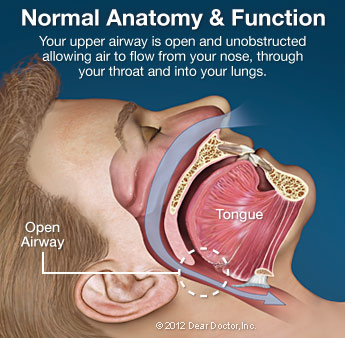
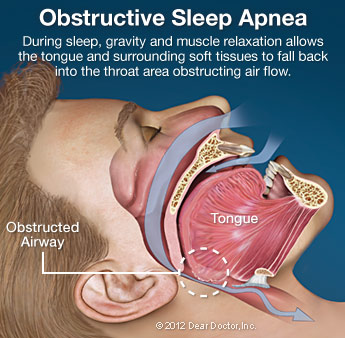
You know it instinctively: A good night's sleep is essential for good health. It makes you feel rested and ready to take on the world. Yet many people don't get the sleep they need. Sometimes this is related to sleep-related breathing disorders (SRBD) — their own, or those experienced by their sleeping partners.
SRBD is characterized by recurrent episodes of reduced or interrupted respiratory airflow. This is caused by soft tissues near the back of the throat collapsing during sleep so that they partially close off the windpipe. These tissues — the tongue, for example — can vibrate as air passes by, causing snoring. Snoring is often worsened sleeping on one's back because this encourages the lower jaw to slip back, which in turn pushes the tongue in front of the airway.
Loud snoring often disturbs the person in the bed who isn't the one doing it, robbing him or her of vital sleep. The snorer, on the other hand, may seem to be slumbering peacefully, but this might not actually be the case. Chronic loud snoring is a common symptom of Obstructive Sleep Apnea (OSA; “a” – without; “pnea” – breath), which occurs when the upper airway is blocked to the point of causing significant airflow disruption, or even no airflow whatsoever for 10 seconds or more. This can be dangerous as reduced airflow into the lungs lowers blood-oxygen levels.
A person with sleep apnea may wake 50 or more times per hour — that's almost once a minute! — without having any memory of it. These awakenings, called micro-arousals, last just long enough to restore muscle tone to the airway so the individual can breathe. Unfortunately, all those micro-arousals preclude deep and restful sleep.
What to Look Out For
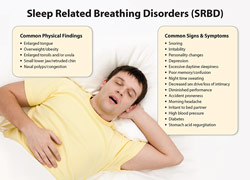
Obstructive Sleep Apnea is a serious matter as it can lead to heart problems and other health issues. It's possible you may have OSA if you snore and also suffer from any of the following:
- Excessive daytime sleepiness
- Irritability
- Poor memory/confusion
- Accident proneness
- Night sweats
- Morning headaches
- High blood pressure
- Obesity
How We Can Help
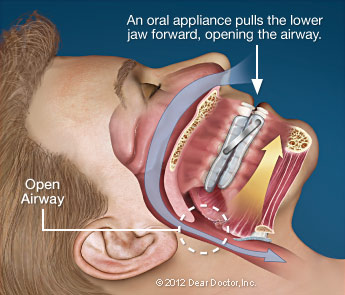 By now you're probably wondering: What does my dentist have to do with all this? Here's the connection: Snoring or sleep apnea can sometimes be treated with an oral appliance available here at the dental office that's designed to hold the lower jaw forward during sleep. This repositioning of the jaw moves the tongue away from the back of the throat, reducing the potential for obstruction. This treatment is backed by a great deal of scientific evidence; it's a good remedy to try before moving on to more complicated breathing devices or surgery to remove excess tissues in the throat.
By now you're probably wondering: What does my dentist have to do with all this? Here's the connection: Snoring or sleep apnea can sometimes be treated with an oral appliance available here at the dental office that's designed to hold the lower jaw forward during sleep. This repositioning of the jaw moves the tongue away from the back of the throat, reducing the potential for obstruction. This treatment is backed by a great deal of scientific evidence; it's a good remedy to try before moving on to more complicated breathing devices or surgery to remove excess tissues in the throat.
Only a dentist can fabricate, fit, adjust, monitor, and treat complications associated with Oral Appliance Therapy used in managing SRBD. So if you or a loved one is experiencing any combination of the signs and symptoms mentioned above, please come in and talk to us about Oral Appliance Therapy (OAT). Even if something beyond OAT is called for in your particular case, we will make sure you get the help you need.
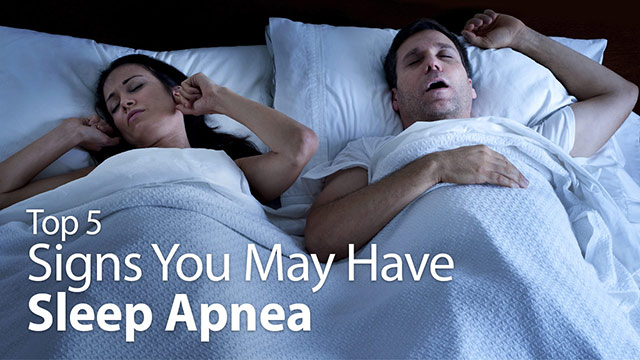
Related Articles
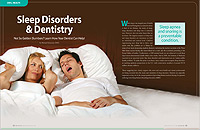
Sleep Disorders & Dentistry If my partner snores loudly, should I be concerned and what can be done to alleviate the problem? Why does my sleeping partner have lapses in breathing while sleeping and is it dangerous? Why do I wake up exhausted even though I get up to 10 hours of sleep at night? The answers to these and other questions — and how dentistry can help — are all revealed within... Read Article
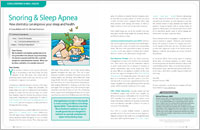
Snoring & Sleep Apnea Snoring is annoying to those who have to listen to it, but it can also signal a serious health condition called Obstructive Sleep Apnea (OSA). Individuals with OSA experience significant airflow disruption during sleep, which in turn can cause a variety of health problems. Learn what to look for and how your dentist can help... Read Article